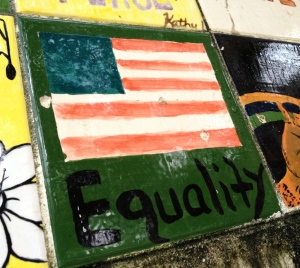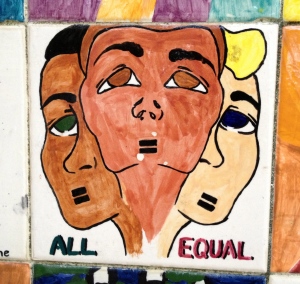“Cultural competence means we’ve been educated about other cultures, humility is how we should be practicing that competence in the field.” So writes social worker Sarah Elizabeth, who blogs at RootedInBeing and got this conversation going.
I agree, Sarah.
As I pondered the implications of this statement it occurred to me that cultural humility, as a further expression of cultural competence, is symbolic of the schism between any theory and its actual practice. Some things sound great on paper, but “where the rubber meets the road,” “in the trenches” and elsewhere in the Land Of Overused Metaphors—it’s different (see “Cultural Humility, Part I – What Is ‘Cultural Humility’?”).
Understanding the reality of this dynamic and how it plays out in so many realms, we serve ourselves and our clients very well to remember (yet again) not to practice from a textbook. When it comes to understanding the unique experience of any given individual, cultural competence is theory, cultural humility is practice.
Quoting my post of August 19—“To practice cultural humility is to maintain a willingness to suspend what you know, or what you think you know, about a person based on generalizations about their culture. Rather, what you learn about your clients’ culture stems from being open to what they themselves have determined is their personal expression of their heritage and culture, what I call their personal culture.”
With this understanding how, then, do we as supervisors and program managers promote cultural humility in the workplace?
By no means is this methodology exhaustive (nor is it intended to be), but is offered as several of many possibilities.
A. Normalize not knowing
As supervisors and managers we have to help our staff become more comfortable with the idea of not knowing. How many meetings have you led where you asked “Any questions?” and not a soul raised their hand? Then, you were followed back to your desk by one or more staffers with questions. Don’t get me wrong, I’m glad those questions got asked, but this scenario typifies the level of discomfort individuals have admitting that there are things they don’t know (I wrote about this in my 8/10/13 post “Structuring Supervision”). Everyone wants to appear competent, and this is no less true with cultural competence.
What puts the humility in cultural humility is the reality that when it comes to understanding our clients and the various cultural influences that helped shape them, there is much more that is unknown than known. Not knowing doesn’t mean you aren’t intelligent, it means you’ve not encountered it before, either abstractly or experientially. If you as a social work practitioner are uncomfortable with the idea of not knowing something, if you equate not knowing with stupidity, it will be a challenge embracing the concept and practice of cultural humility. Supervisors and managers, we need to instill in our staff the understanding that it is not only okay to not know—it is a necessary condition for growth, central to the practice of cultural humility and good social work practice.
B. Create a culture-based client self-assessment tool
An intake instrument using closed- and open-ended questions can allow clients to define their personal culture; to share with us (to the extent they are comfortable) those aspects of nationality, ethnicity, religion, gender preference, and any other aspects of their experience that comprise how they self-identify.
Most of the intake instruments I’ve come across are of the check-box types that go no further in exploring culture than asking you to indicate your ethnicity. This is beyond inadequate—it does next to nothing in terms of telling you about the unique cultural experience of any given client. I’ll be the first to admit, I can’t think of a one of us who wants to complete more paperwork when entering a doctor’s office or any other system. But at the very least we need to convey the respect of letting our clients know that the total of all the factors shaping their cultural self-identification is not going to be reduced to a single check box. We need to offer them a mechanism by which they can be seen and heard—an instrument such as this affords that opportunity. While our clients have the right to refuse to complete it, we as practitioners can nonetheless remain vigilant and true in our practice of cultural humility.
C. In-service: A cultural self-identification workshop
One of the best possible ways to help staff grasp the importance and power of cultural humility is to make it personal. As a supervisor or program manager you can lead an in-service style conversation where staff members self-report how they differ from the cultural stereotypes others may believe about them. In so doing they can come to better understand the concept of a personal culture, providing them with a theoretical framework for seeing the ways in which their clients may be both a product of, and separate from, their respective cultures. And the good news is that as a leader, you get to go first!
Here are some questions to guide the discussion.
- Starting with ethnicity and religion, which cultural “check boxes” would you check on a questionnaire?
- What are some of the cultural qualities and or stereotypes ascribed to someone of your ethnic and religious background?
- In what ways do you differ from those stereotypes?
There are certainly other kinds of culture-based questions you may or may not want to pose, depending on the size and comfort level of your staff, time considerations, et cetera. But even if you limited the conversation to these three questions, the point will be made. As staffers share their responses, the inherent limitation of practicing from a purely culturally competent standpoint will be revealed, and a deeper understanding of cultural humility promoted.
The practice of cultural humility suggests, on some level, that we ought to forget our training in cultural competence and see our clients’ personal culture as unique (which it is) and based on nothing other than who they are right now. Yet this would be a mistake. The best use of our training in cultural competence is to help us formulate the most useful questions to ask our clients about who they are and what experiences shape their current dilemma—not to label them, put them in a box, see them as a “Hispanic male” rather than as “Mr. Rodriguez,” or make any other assumptions about these vastly complex individuals. We are our best selves as professionals if we are serving from an assumption that we don’t know what our clients know—a blatant truth which can sometimes get lost as we seek to draw from a generalized pool of knowledge in our effort to understand. Our expertise, then, is tapping into their expertise on themselves, their experiences, and their abilities. Together, one step at a time, we are then in the best possible position to help each culturally unique individual move inexorably toward the achievement of their dreams.
Special thanks to Sarah Elizabeth at RootedInBeing for using ‘Suggest A Topic’ to begin this conversation on cultural humility. You may visit Sarah at:
http://rootedinbeing.wordpress.com/
A Request
If anyone knows of the existence of something akin to a culture-based client self-assessment tool, kindly let me know. I’d love to see one. Sometimes, detailed intake and assessment instruments form a component of customizable social services database software, and a template can be printed out. If it is against the policy of your organization to reproduce in any form or share such information, please keep yourself in compliance with that policy. Thanks.



